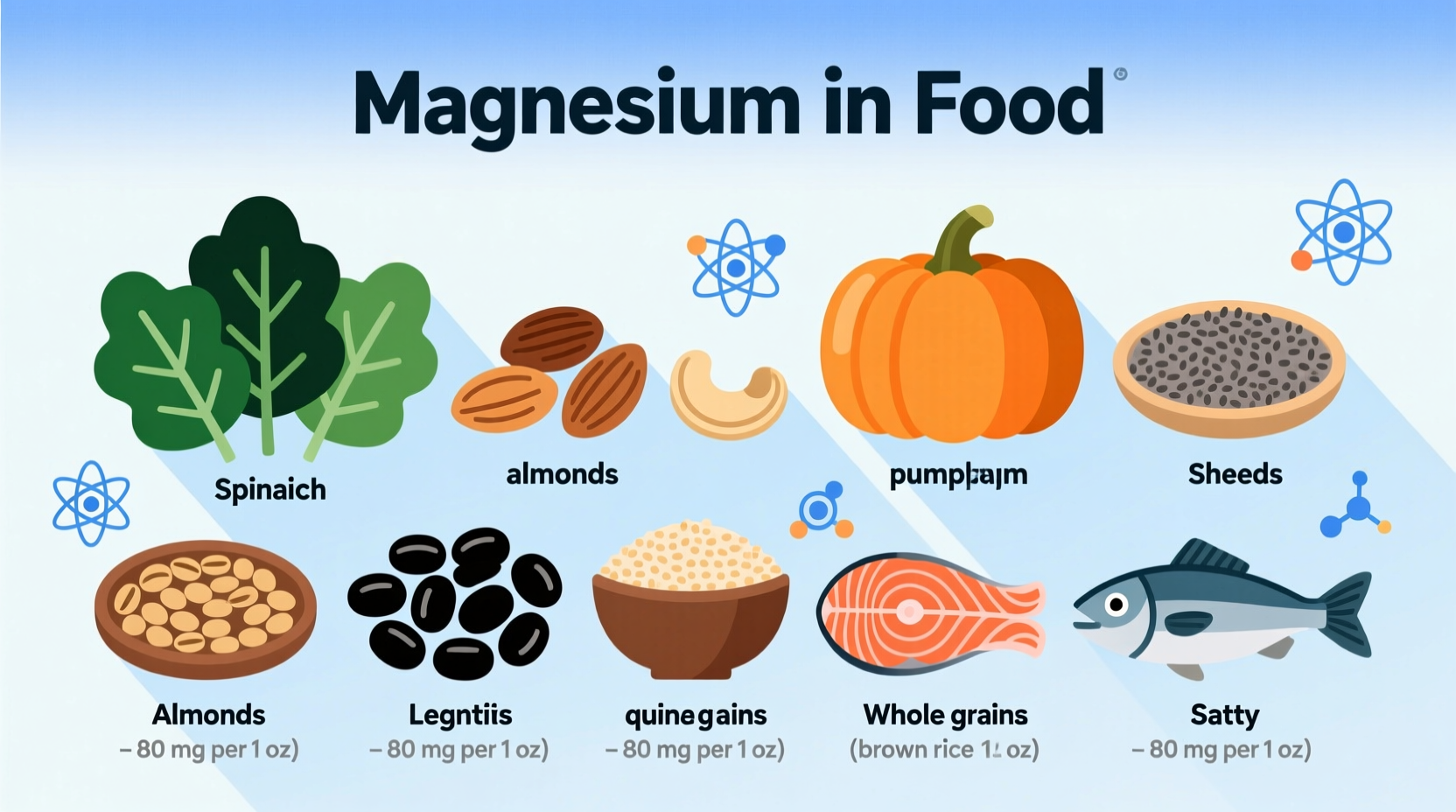When you're exploring what is magnesium in food, you're tapping into one of nature's most essential mineral delivery systems. This guide cuts through the confusion to give you exactly what you need: verified food sources, practical absorption tips, and science-backed health insights you can apply immediately.
Understanding Magnesium: Nature's Multitasking Mineral
Magnesium isn't just another nutrient—it's a foundational element involved in more than 300 enzymatic reactions in your body. When we talk about magnesium in food, we're referring to the naturally occurring form found in whole foods that your body recognizes and utilizes efficiently. Unlike isolated supplements, food-based magnesium arrives with natural companions like fiber, vitamins, and phytochemicals that work synergistically to boost absorption.
The discovery of magnesium's importance in human nutrition unfolded over centuries. Ancient civilizations intuitively consumed magnesium-rich foods like leafy greens and nuts, though they didn't understand the science. Modern recognition began in 1926 when researchers first established magnesium's critical role in chlorophyll—the green pigment in plants. By the 1930s, scientists connected magnesium deficiency to specific health conditions, and today we understand its vital involvement in DNA synthesis, blood sugar regulation, and nervous system function.
Top Dietary Sources of Magnesium
Knowing which foods deliver the most magnesium helps you make strategic dietary choices. The following table shows verified magnesium content per standard serving from USDA FoodData Central:
| Food Source | Serving Size | Magnesium (mg) | % Daily Value |
|---|---|---|---|
| Pumpkin seeds | 1 oz (28g) | 156 | 37% |
| Spinach, cooked | 1 cup | 157 | 37% |
| Almonds | 1 oz (23 nuts) | 80 | 19% |
| Black beans | 1/2 cup | 60 | 14% |
| Avocado | 1 medium | 58 | 14% |
| Dark chocolate (70% cocoa) | 1 oz | 64 | 15% |
Notice how plant-based foods dominate the top magnesium sources. This pattern reflects magnesium's central role in chlorophyll—the compound that makes plants green. When selecting magnesium-rich foods, prioritize minimally processed options as refining processes can strip away up to 80% of natural magnesium content.

Why Food-Based Magnesium Outperforms Supplements
Research from the National Institutes of Health reveals that magnesium from whole foods has significantly higher bioavailability than most supplements. The natural matrix of foods contains compounds that enhance magnesium absorption while reducing potential digestive discomfort sometimes associated with supplements.
Consider these practical absorption factors when incorporating magnesium-rich foods:
- Pair with vitamin D sources—fatty fish or egg yolks boost magnesium utilization
- Avoid excessive phytates—soaking nuts and seeds reduces compounds that can inhibit absorption
- Combine with fiber-rich foods—supports steady mineral absorption throughout digestion
- Limit high-zinc foods in the same meal—excessive zinc can compete with magnesium absorption
These context boundaries matter because magnesium absorption operates within specific physiological parameters. Your body can typically absorb only 30-40% of dietary magnesium, with absorption rates decreasing as intake increases—a natural safeguard against toxicity from food sources.
Building Your Magnesium-Rich Diet
Creating a magnesium-supportive diet doesn't require drastic changes. Start with these practical strategies that fit real-world eating patterns:
Morning Boost
Add a tablespoon of chia seeds or flaxseeds to your breakfast smoothie or oatmeal. Just two tablespoons provide approximately 100mg of magnesium—nearly a quarter of your daily needs. Pair with a banana for additional magnesium and potassium synergy.
Lunch Transformation
Replace refined grains with magnesium-rich alternatives. Swap white rice for quinoa (118mg per cooked cup) or choose whole-wheat bread instead of white. Add a generous portion of dark leafy greens to your salad—cooked spinach delivers twice the magnesium of raw.
Smart Snacking
Keep a small container of almonds or cashews at your desk. A single ounce provides nearly 20% of your daily magnesium needs while satisfying cravings healthfully. For sweet cravings, reach for dark chocolate with at least 70% cocoa content.
Dinner Optimization
Incorporate legumes like black beans or edamame into your evening meals. A half-cup serving delivers significant magnesium along with protein and fiber. Finish with a small square of dark chocolate for dessert—both satisfying and nutrient-dense.
Recognizing Magnesium Needs in Different Life Stages
Your magnesium requirements shift throughout life. According to the National Academy of Medicine, adult men need 400-420mg daily while women require 310-320mg, with increased needs during pregnancy (350-360mg). Athletes may need up to 20% more magnesium to support muscle function and recovery.
Certain conditions affect magnesium needs:
- Type 2 diabetes often increases urinary magnesium excretion
- Gastrointestinal disorders can impair absorption
- Regular alcohol consumption depletes magnesium stores
- Long-term use of certain medications affects magnesium levels
However, food sources remain the safest approach for most people. The NIH notes that magnesium toxicity from food alone is virtually impossible—your body naturally regulates absorption based on current needs.
Putting Magnesium Knowledge Into Action
Start tracking your magnesium intake for three days using a simple food journal. Focus on incorporating at least three magnesium-rich foods daily. Notice how your energy levels, muscle recovery, and sleep quality respond over two weeks. Remember that consistency matters more than perfection—aim for gradual improvement rather than immediate overhauls.
For those exploring what is magnesium in food, the key insight is recognizing that nature packages this mineral with everything your body needs for optimal utilization. By prioritizing whole food sources, you're not just getting magnesium—you're accessing a complete nutritional ecosystem that works harmoniously with your physiology.











 浙公网安备
33010002000092号
浙公网安备
33010002000092号 浙B2-20120091-4
浙B2-20120091-4